Honoring Indigenous Cultures with Granite Memorial Monuments

Honoring Indigenous Cultures with Granite Memorial Monuments

Granite, a material known for its durability and timeless appeal, offers more than just physical permanence. It is an ideal medium for memorials that aim to reflect the strength and endurance of Indigenous cultures, which have survived centuries of hardship, colonization, and displacement. Unlike other materials that may weather and degrade over time, granite monuments stand resilient, much like the cultures they represent. These monuments do not simply mark a moment in time; they serve as a living testament to the ongoing presence and vitality of Indigenous communities.
For many Indigenous peoples, the creation of such monuments is not just about remembering the past, but also about educating future generations. Too often, the stories of Indigenous cultures have been marginalized or overlooked, their rich traditions reduced to mere footnotes in the larger narrative of history. Granite memorials, however, offer an opportunity to reclaim that history and to share it with the wider public in a way that is both accessible and enduring.
One example of this can be seen in the establishment of memorials dedicated to Indigenous leaders and warriors, who fought not only for their land but for the survival of their people. These figures—some well-known, others largely forgotten—are given the recognition they deserve through the artistry of granite carving. Each stone is carefully crafted to reflect the spirit and dignity of the individual it honors, while also embodying the collective memory of a people who have long been silenced.

Consider, for instance, the memorials that honor Indigenous stewardship of the land. These monuments recognize the deep and spiritual connection that many Indigenous cultures have with the environment, a relationship that predates modern conservation movements. In a time when environmental issues are at the forefront of global consciousness, these memorials highlight Indigenous knowledge systems that have been protecting the land for millennia. Through such granite structures, the wisdom of Indigenous peoples can find a place within broader environmental discussions, reminding us all of the importance of respecting the natural world.
Creating granite memorial monuments also provides an avenue for healing. For many Indigenous communities, the act of memorializing their culture and history is deeply personal. It acknowledges past injustices and gives voice to those who were silenced by colonization. It’s an act of reclaiming space, both physically and symbolically. These monuments not only honor the memories of the past but also contribute to the ongoing movement for Indigenous rights, cultural revitalization, and sovereignty.
Moreover, granite as a medium is inherently connected to the earth, often sourced from the very land Indigenous peoples have cared for over centuries. This connection between material and meaning enhances the significance of the memorials, creating a deeper bond between the monument and the land it represents. The weight and permanence of granite provide a stark contrast to the transient nature of much of modern life, reminding us that some things—like culture, identity, and history—are meant to endure.
In cities, towns, and remote regions alike, these granite memorials are becoming more than just markers of the past. They are active participants in the ongoing dialogue between Indigenous and non-Indigenous communities, inviting all people to reflect on the history that has shaped their shared world. With every chiseled line and every engraved image, these monuments offer an opportunity for understanding, for bridging divides, and for honoring a culture that has often been marginalized but never extinguished.
Granite memorials, in their quiet strength, carry a profound message: Indigenous cultures are not relics of the past but living, evolving forces that continue to shape our world. As we honor their legacy with these enduring monuments, we are reminded that the preservation of culture and history is not just an act of remembrance—it is an ongoing commitment to respect, understanding, and, ultimately, to reconciliation. Through granite, we build not only monuments to the past but pathways to a more inclusive and just future.
